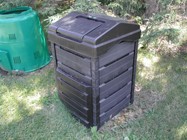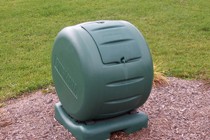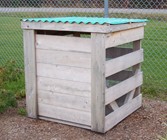Pens
One of the simplest structures is a circle of snow fencing or wire mesh supported by posts or stakes. At turning time, you unwrap and remove the fencing, set it up in a new location nearby, and fork the compost back into the pen. This requires a little more space and some lifting effort, and it leaves the compost in full view; but it is inexpensive, strong enough, and very easy to construct.
Bins
Bins are sturdier and more discreet than pens. They may require a little more skill to build but are still inexpensive. The four sides can be made of almost anything: wire screen stretched on wooden frames or old pallets standing on end. Three walls are normally fixed permanently together, but may be hinged, hooked or tied. One design has three walls of concrete blocks, stacked without mortar, and a fourth wall of removable boards.
To turn the pile, the front of the bin is removed and the compost forked out onto the ground. Then the pile is rebuilt in the bin. You do need the extra ground space in front of the bin for turning, but you don't have to lift the compost over a wall to get it back in. One variation calls for the bin to be set over a pit, to provide extra insulation. Although this encourages the presence of helpful earthworms, it does mean reaching down below ground level to turn the compost.
The Compost Container
Boxes
Perhaps the best small-scale system for the relatively energetic composter is a design known as the New Zealand box. A bottomless wooden box with ventilation spaces between the wall boards, its face is easily removable to facilitate turning. Since the compost rests directly on the ground, a lid is normally added to prevent nutrients leaching from the pile during heavy rains.
A New Zealand box or something similar can be made at home with a minimum of skill. It can be moved to a new location fairly easily, if required, and it keeps the compost neatly out of sight.
A popular variation has two or three compartments in a row: compost is turned from one box into another; the emptied box then accumulates the makings for another batch. It is ideal for people who use kitchen and yard wastes as they accumulate and can't save up enough materials to make a really big pile.

Anyone who has come back home after a long holiday knows that, given enough time, organic matter can decompose even in the back of the fridge. Out in the backyard, nature certainly doesn't care whether the compost is heaped out in the open or enclosed in a bin.
However, a container of some sort does help to keep the yard neat and the neighbours happy. A covered container also means the pile can retain both heat and nutrients, while keeping out rodents, raccoons and pets.
Hot compost piles need regular turning, and you'll want to harvest finished compost from time to time. So, above all, the container should make it easy to do this work. Beyond that consideration, you're safe in choosing a container for its appearance, convenience, cost, size, or other qualities.

All sorts of composting units are available commercially. Some are simply "digesters," such as a cone covering a collecting basket in a pit. Others, with solid bases, have doors or chutes to let you harvest the compost from the bottom and put it to use.
Your own system may be as simple as a circle of chicken wire, or a bottomless barrel with air holes in its sides. Just lift it away from the pile, set it up again nearby, and put the newer layers back in, leaving behind the finished compost.

Drums
A rotating barrel composter can be made from a large drum with aeration holes punched in it, and fins inside to lift and mix the compost materials. A hinged loading door in the side allows wastes to be added gradually. Some are rolled on the ground to mix the contents; others are mounted horizontally on stands with crank attachments. Various commercial models are available.
If bacteria is introduced with a good amount of garden soil and the barrel is turned every few days, compost can be made in a few weeks this way with little physical effort.

Perhaps the best small-scale system for the relatively energetic composter is a design known as the New Zealand box. A bottomless wooden box with ventilation spaces between the wall boards, its face is easily removable to facilitate turning. Since the compost rests directly on the ground, a lid is normally added to prevent nutrients leaching from the pile during heavy rains.
A New Zealand box or something similar can be made at home with a minimum of skill. It can be moved to a new location fairly easily, if required, and it keeps the compost neatly out of sight.
A popular variation has two or three compartments in a row: compost is turned from one box into another; the emptied box then accumulates the makings for another batch. It is ideal for people who use kitchen and yard wastes as they accumulate and can't save up enough materials to make a really big pile.
